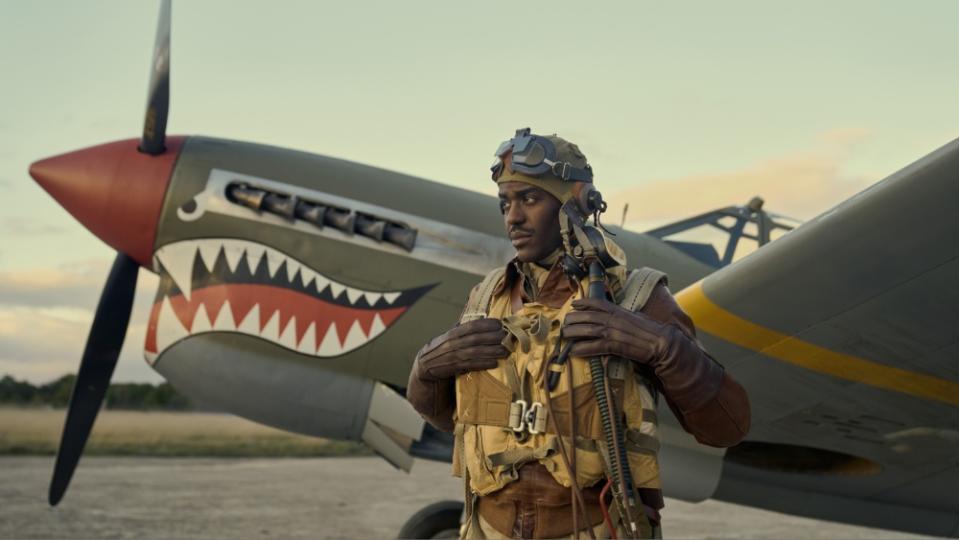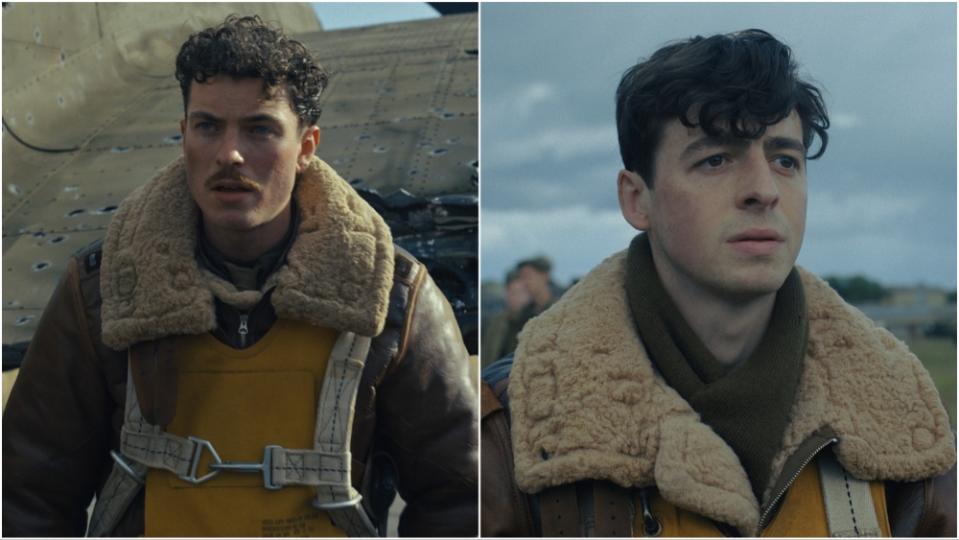Austin Butler Broke a Rib While Shooting ‘Masters of the Air,’ but He ‘Had to Keep Fighting’: ‘It Was an Honor to Play These Men’

Just a week after wrapping on Baz Luhrmann’s “Elvis” biopic, Austin Butler arrived in the U.K. to start work on Steven Spielberg and Tom Hanks’ epic World War II drama “Masters of the Air.”
He was joined on the Amblin and Playtone co-production by a cast who, like Butler, are poised to become the next generation of Hollywood leading actors, among them Callum Turner, Barry Keoghan, Anthony Boyle, Ncuti Gatwa and Nate Mann. Together, the band of brothers went through what was effectively a World War II bootcamp, encompassing lessons on everything from marching and dancing to etiquette and history. “It really built such bonds between all of us,” Butler tells Variety of the experience.
More from Variety
Created by John Shiban and John Orloff, “Masters of the Air” tells the story of the U.S. airforce’s 100th bomb group – nicknamed the Bloody Hundredth for the inordinate loss of life they suffered – who were stationed on the coast of England during the climax of the war. Butler plays Major Gale “Buck” Cleven while Turner is his best friend, Major John “Bucky” Egan. Together, the natural born pilots shepherd their squadron through some of the deadliest battles of the period until their luck finally runs out. To prepare for their roles as masters of the air, the actors were also drilled on cockpit procedures such as take-off and landing as well emergency protocols when an engine catches fire.

Playtone co-founder Gary Goetzman, who produced the nine-episode series, says he, Spielberg and Hanks wanted to highlight both the granular detail and superhuman efforts of the airforce, from lingering shots of the pilots flicking switches in preparation for take-off to staccato scenes of horror in the clouds, with pilots suffering from claustrophobia, air sickness, frostbite and gunshot wounds. “We’re all very detail-oriented guys,” Goetzman tells Variety. “Lots of people in a show don’t want to go too deep, don’t want to spend much time firing up the planes and hitting the controls. We really enjoy that. If Tom [Hanks] had his way, you would see them flying for the hours that they really had to fly to get to the flak [German anti-aircraft cannons]. He’d just want to hang on that forever.”
“Masters of the Air” is the third in Amblin and Playtone’s World War II trilogy, following 2001’s paratrooper drama “Band of Brothers” (which at the time was the most expensive television show ever made) and 2010’s “The Pacific” about the U.S. marines. It was Spielberg’s father, himself an air force veteran, who encouraged the director to make the latest installment but, with so much of the action taking place in the air, the team had to wait until the technology had caught up to make it possible.
While many of the aerial fight scenes were CGI, the production team did build some B-17 planes as well as cockpits, fuselage and tail gunner positions, among other props. “It’s just using any technique and any technology that we felt served it,” Goetzman says of the series, which he estimates cost between $250-300 million, eclipsing the budget for “Band of Brothers.” (The COVID-19 pandemic was partly responsible for pushing up the costs).
“What I really love about this show is that there’s the old school way of doing it, which is building the barracks and using the airport — they built 81 buildings — and the new school way of doing things,” Turner says. “And that technology blew my mind. It was a shoehorn of high-definition screens playing out what’s actually happening in front of you, and we’re on a gimbal in the plane 50 feet up and reacting in sync to what you see.”

While Butler and Turner claim they didn’t suffer from any motion sickness on the gimbals — enormous gyroscopes that mimicked the motion of dodging rocket fire 30,000 feet in the air — they spent so many hours on the contraptions, sometimes up to eight hours at a time, they used to “joke that we got jetlag,” reveals Turner.
“Because it’s so hard to get down — it’s a whole thing to get down — so they keep you in the plane,” Butler explains. “It’s just easier.”
The gimbals weren’t the only discomfort the actors experienced during the shoot. Butler even broke a rib. “There was a fight scene and yeah, my rib cracked,” he says. “It hurt and then I had to keep fighting. And it hurts for a long time after because every time you breathe, you feel your ribs. But it could have been worse.”
As well as numerous white-knuckle aerial battles (and subsequent crashes), the 10-month shoot included scenes set in prisoner of war (POW) camps and forced marches at gunpoint through arctic temperatures. “I remember thinking this is gonna be a long haul,” Butler says of first reading the script. But with Spielberg, Hanks and Goetzman on board it was a no-brainer, not to mention the chance to portray the World War II heroes themselves. “The opportunity and the honor of playing these men who we owe such a debt of gratitude to — the privilege outweighed any daunting timeline of it or anything,” Butler says.
For Turner, whose grandfather joined the war at the age of 16 before being captured and interned at a POW camp, there was also a personal draw. “I just grew up on stories of him from my family,” he says. “So I’m so glad I get to be part of a series that sheds light on that story, because they deserve it. They’re real-life superheroes and we wouldn’t be here if it wasn’t for them.”
To both the actors’ delight, Spielberg and Hanks were in touch throughout the shoot, sending messages and photos. Hanks even flew to the U.K. to give the 120-strong cast a “rousing speech” during boot camp, Butler recalls.
While Spielberg, Hanks and Goetzman have long been obsessed with bringing World War II to the screen, “Masters of the Air” has coincided with a resurgence in high-end productions set in that period — from John Travolta short film “The Shepherd,” which also touches on the U.S. air force, to Christopher Nolan’s “Oppenheimer,” which deals with the end of the war and Steve McQueen’s upcoming movie “Blitz.”
Goetzman says he doesn’t focus too much on what other filmmakers are doing (and “Masters of the Air” has been almost a decade in the making), but he understands the appeal. “I think people in general can gravitate to World War II stories involving Hitler because it was black-and-white,” he says. “It’s very simple who the good guys are, the bad guys, heroes, villains. And the stakes were always very high.”
“It just kind of felt right now to go back into that and show people a piece of history, especially in America,” he continues. “They kind of know — but you’d be surprised how forgetful the world is.”
Best of Variety
Sign up for Variety’s Newsletter. For the latest news, follow us on Facebook, Twitter, and Instagram.

 Yahoo Lifestyle
Yahoo Lifestyle 
